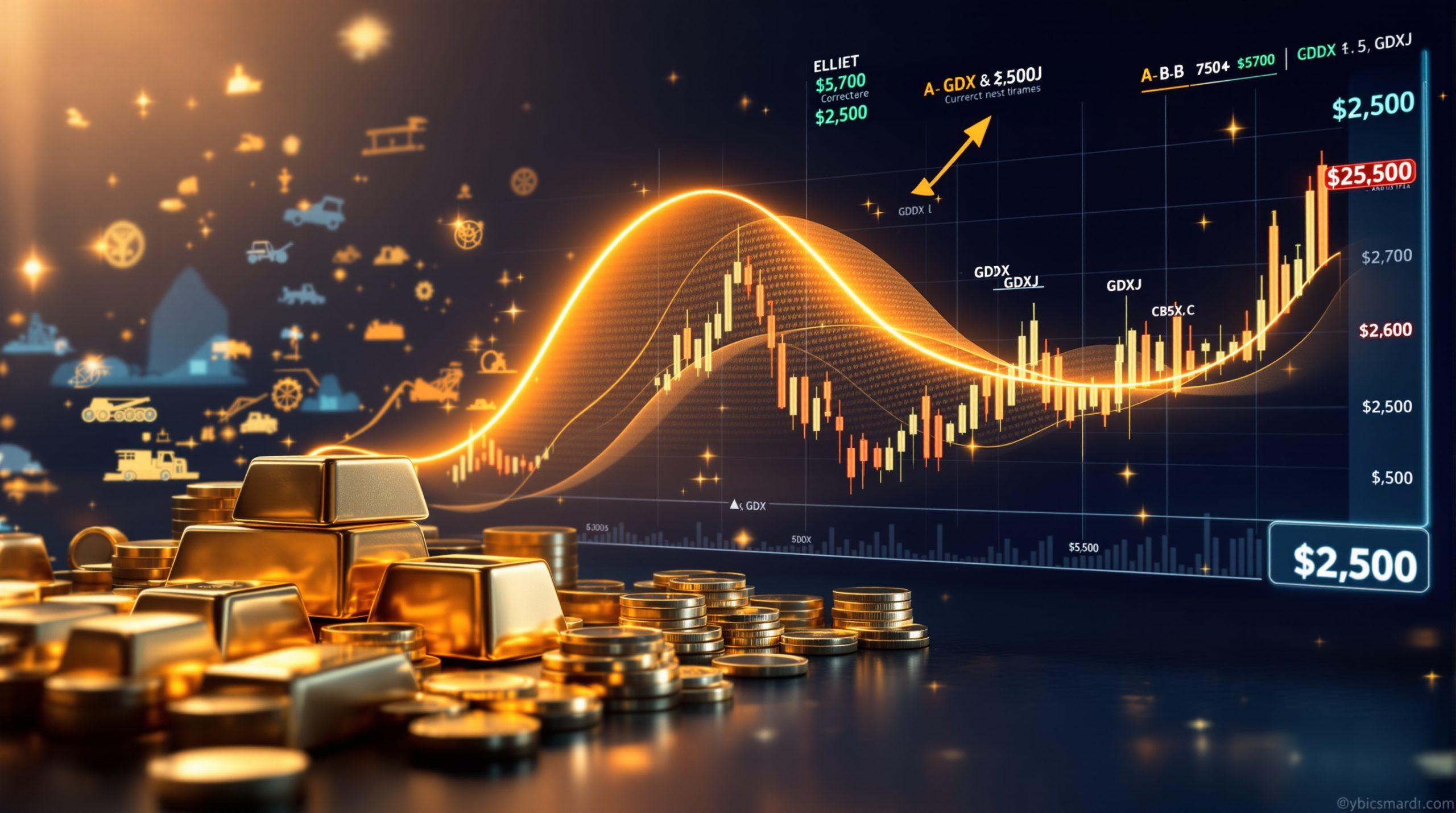Gold and Copper Prices Extend Decline Amid Tariff Aftershock: A Comprehensive Analysis of Market Dynamics
Gold and copper prices experienced significant volatility in early April 2025, with gold retreating below the $3,000-per-ounce threshold and copper facing its worst three-day performance since the 2008 financial crisis. These fluctuations reflect broader market dynamics explained driven by escalating U.S.-China trade tensions, fears of a global recession, and strategic repositioning by institutional investors. Despite gold's 15% year-to-date gains, both metals now face sustained pressure from accelerated tariff implementation timelines and shifting trade patterns. This report examines the interconnected drivers of these trends, analyzes expert perspectives, and evaluates the implications for global commodities insights markets.
What's Causing the Gold Price Decline?
Recent Price Movements and Volatility
Gold's descent below $3,000 per ounce on April 7, 2025, marked a reversal from its record highs three weeks prior, with spot prices swinging between $2,973.74 and $3,054.85 during a single trading session. By 11:00 a.m. ET, spot gold settled at $3,001.14, reflecting a 1.2% intraday decline, while U.S. gold futures mirrored this trajectory at $3,020.10.
This volatility contrasts with gold's status as a traditional safe-haven asset, underscoring the exceptional nature of current market conditions. The metal's instability coincided with extreme equity market swings, including a 7% intraday range for the S&P 500—the widest since March 2020's pandemic-driven collapse.
Market Dislocation Factors
The paradox of gold's decline amidst geopolitical tensions stems from liquidity demands in other asset classes. Vasu Menon, Managing Director of Investment Strategy at Oversea-Chinese Banking Corp., noted: "We are seeing profit-taking to cover significant losses in equity markets and probably due to margin calls".
This forced selling occurred despite gold's fundamental strengths, including its role as an inflation hedge and store of value. The metal's 2025 performance remains robust at +15% year-to-date, largely fueled by President Trump's tariff policies that disrupted global trade flows starting in late 2024. However, short-term volatility has intensified as institutional investors rebalance portfolios to meet risk management protocols.
Gold's Performance in 2025
Gold's resilience throughout 2025 derives from multiple factors:
-
Tariff-Driven Demand: Trump's "reciprocal" tariffs on Chinese goods prompted central banks to accelerate gold acquisitions, with Germany reportedly considering repatriating 1,200 tonnes from U.S. vaults.
-
Inflation Hedge: Consumer price indices in major economies remained elevated at 4–6%, sustaining retail investment flows into bullion.
-
Technical Breakouts: The breach of $2,900/oz in January 2025 triggered algorithmic trading momentum, amplifying upward moves.
Despite recent corrections, analysts maintain long-term bullish outlooks given unresolved trade disputes and sustained central bank buying. For a deeper understanding, consider this comprehensive gold market analysis of current trends and future predictions.
How Are Copper Markets Responding to Tariff Threats?
Copper's Dramatic Price Collapse
Copper's 7.7% plunge on April 7 capped a three-day 18% decline—the sharpest since Lehman Brothers' collapse in 2008. London Metal Exchange (LME) three-month contracts tumbled to $8,780/tonne, while COMEX futures hovered near $10,000.
This reversal followed a late-March surge as traders rushed to ship supplies ahead of anticipated U.S. tariffs, creating an artificial supply glut when implementation timelines accelerated. The whipsaw action included a $1,000 intraday rebound within two hours on April 7, highlighting extreme market fragility.
Unprecedented Market Volatility
The copper market's structure amplified price moves:
-
Speculative Positioning: Hedge funds held net-long positions equivalent to 15% of annual global production by March 2025.
-
Chinese Demand Response: State-owned enterprises reportedly acquired 200,000 tonnes during the sub-$8,500 trough, leveraging price dislocations.
-
Tariff Arbitrage: Traders initially front-ran expected tariffs by redirecting South American supplies to U.S. ports, only to reverse course as China imposed counter-tariffs on refined copper.
This volatility reflects copper's dual role as both an industrial commodity and financial asset, with algorithmic trading accounting for 40% of daily volume. Understanding copper price dynamics becomes crucial for investors navigating these turbulent markets.
Expert Analysis on Copper's Outlook
Sabrin Chowdhury, Head of Commodities at BMI (Fitch Solutions), warned in a recent report: "The strong likelihood of a severe downturn in metals demand in a full-blown trade war will keep prices under pressure for coming weeks". Key risk factors include:
-
Chinese Stimulus Efficacy: Despite rumors of accelerated infrastructure spending, property sector debt (30% of copper demand) remains a drag.
-
Inventory Dynamics: LME stockpiles doubled to 250,000 tonnes in Q1 2025, eroding backwardation premiums.
-
Substitution Risks: Aluminum and composites gained market share in electrical applications at $9,000+ copper prices.
What's the Connection Between Tariffs and Metal Prices?
Trump's Tariff Policies and Market Impact
The Trump administration's April 2025 tariff escalations targeted $300 billion in Chinese imports, including rare earth minerals critical for defense and clean energy. China retaliated with export restrictions on tungsten, tellurium, and molybdenum—materials essential for semiconductors and renewable energy systems.
This tit-for-tat dynamic disrupted metals supply chains in three ways:
-
Logistical Bottlenecks: Pre-tariff stockpiling overwhelmed U.S. West Coast ports, increasing warehousing costs by 22%.
-
Currency Effects: The yuan depreciated 5% against the dollar in March 2025, inflating dollar-denominated metal costs for Chinese buyers.
-
Futures Curve Distortion: LME copper contango widened to $150/tonne, incentivizing speculative storage plays.
International Trade Tensions
Germany's potential gold repatriation signals eroding trust in U.S.-led financial systems, with Bundesbank officials citing "geopolitical uncertainty" as justification. Meanwhile, China's rare earth export controls threaten to:
-
Increase permanent magnet production costs by 35%.
-
Delay 500 GW of planned global wind installations through 2030.
-
Accelerate Western mining investments in Africa and Australia, though project lead times remain 5–7 years.
Economic Recession Fears
Copper's status as a "Dr. Copper" economic indicator flashed warning signs:
-
Global PMI Contraction: Manufacturing indices fell below 48 in March 2025 (50 = growth).
-
Yield Curve Inversion: U.S. 10Y–2Y spreads reached -1.2%, historically preceding recessions.
-
Commodity-Linked Currencies: The Chilean peso and Australian dollar depreciated 12% and 9% respectively in Q1 2025.
These factors compounded to suppress industrial metal demand while boosting gold's strategic appeal—a dichotomy temporarily overshadowed by liquidity crises. As Bloomberg reports, the market continues to reassess the implications of these tariff disputes.
FAQ: Gold and Copper Market Outlook
Why is gold falling despite geopolitical tensions?
Gold's inverse correlation with equity markets broke down during forced liquidations, as margin calls compelled institutional investors to sell liquid assets like bullion. However, its 15% YTD gain still outperforms most asset classes. For detailed insights, consider this gold price analysis examining current influences.
What caused copper's dramatic price swings?
A feedback loop developed between algorithmic trading systems and physical market disruptions. High-frequency traders amplified moves triggered by tariff news, while Chinese state buyers exploited dips below production costs.
How are tariffs affecting metals markets?
Tariffs distorted traditional trade routes, creating transient regional shortages and gluts. The U.S. imported 40% more copper from Chile in March 2025 vs. 2024, while Chinese bonded warehouse stocks hit record highs.
What are experts predicting for metals prices?
Analysts anticipate continued volatility with gold and copper prices decline amid tariff aftershock, with gold testing $3,200/oz by 2026 if tariffs persist, while copper could range between $8,000–$9,500/tonne until trade policies stabilize.
In conclusion, the 2025 metals market crisis underscores the fragility of globalized supply chains in an era of resurgent protectionism. While gold's long-term fundamentals remain sound, copper's path hinges on resolving trade disputes and reviving industrial demand—a precarious balance in the current geopolitical climate.
Worried About Navigating the Volatile Metals Market?
Stay ahead of potential mining and exploration opportunities by receiving real-time alerts on significant ASX mineral discoveries through Discovery Alert, powered by the proprietary Discovery IQ model. Explore how major mineral discoveries can lead to substantial market returns by visiting the Discovery Alert discoveries page and start your 30-day free trial today.




